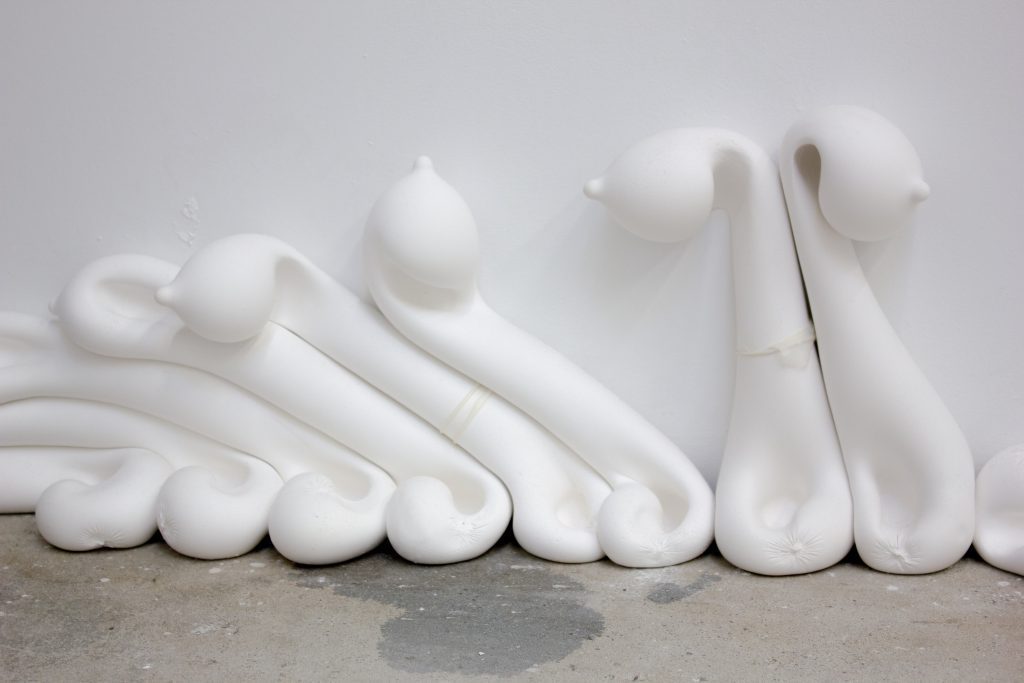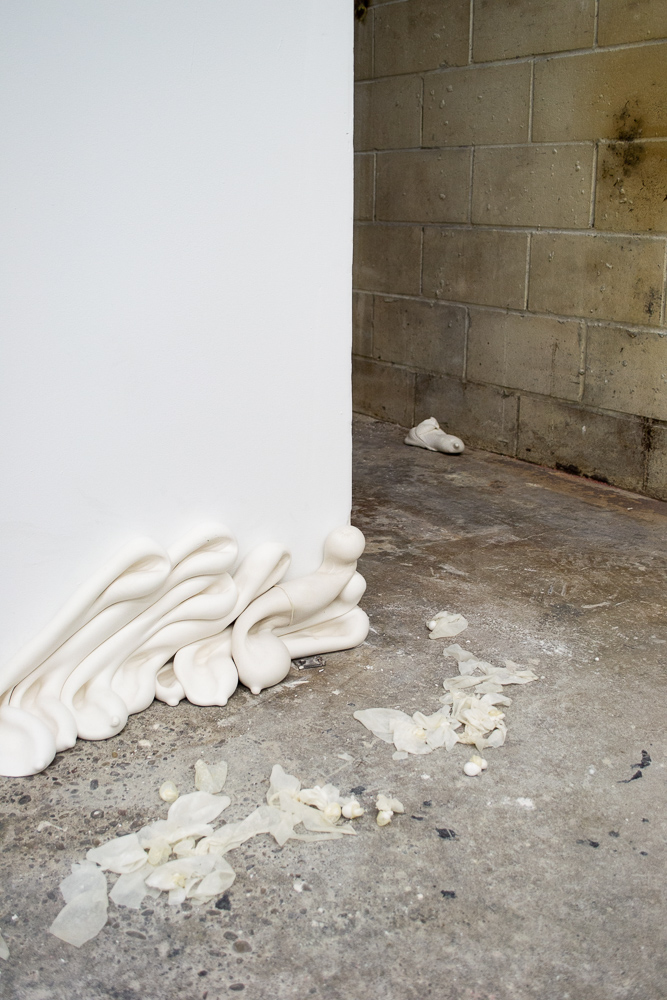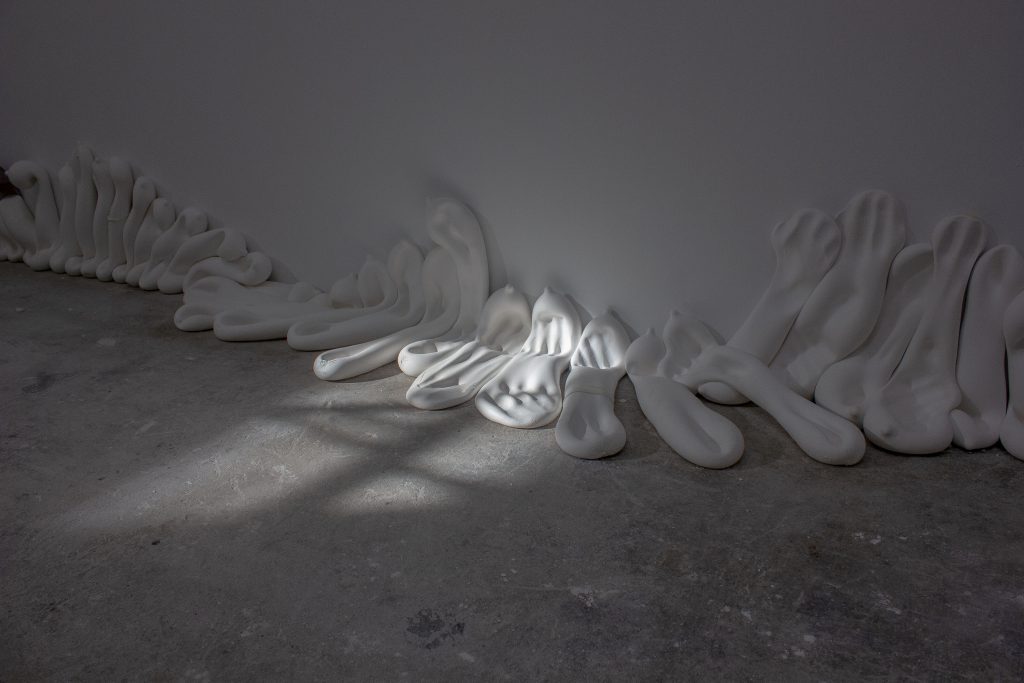Ursula’s Garden at Sibling
4 August 2021
By Alex Lepianka
I am surrounded by two hundred and twenty-two plaster polyps cast in place along the perimeter of Sibling’s gallery floor. The forms, which make up Robert Anthony O’Halloran’s installation Ursula’s Garden, are nippled, bellied and creased, with a rare few still stretching the condoms in which they were cast. Pushed up against the wall or slumped onto the floor, collapsing, tired and erect, the castings demarcate a lively zone within the gallery. There is humour to O’Halloran’s installation, and it hits like a scrap of itinerant latex flung, forgotten and rediscovered in a faraway corner of my bedroom the morning after a low-consequence fuck. O’Halloran’s garden is not the underwater Disney hell that the show’s title references, but neither does it realize a place of oceanic, post-coital peace. Instead, each one of its castings strikes an irreplicable pose, hardened or perhaps exhausted by its once-living desires.
In shape, posture, and personality, the castings appear as distinct individuals even as they clamber over and collapse onto one another. Individually numbered and catalogued, the polyps in fact belong to a well-ordered whole, a composition unified like a sequence of moments in an unfolding process. But, as Emma Sharpe notes in her review for Canadian Art, the effusive beings of the garden slip away from the kind of determinacy that language would prescribe them. If these creature-fossils do belong to a species, their nature is not immediately clear from these individual remains.
Planted along the edges of the floor, the castings make a striking first impression as a boundary within the gallery. A sweep of detritus from the casting process closes off the perimeter, encircling the viewer within a wave of plaster bodies, latex, and rubble. As the viewer crosses over into the garden, they enter a space of supple, curving bodies rather than right angles and smooth planes. I sense how the titular word, garden, is appropriate to describe this setting, given the ecology of bulbous forms lilting like poppies or the anthropoid figures one glimpses in the bushes of a pleasure-park. But ecologies also appear in funerals, symposia, and orgies, where systems of things exist in various states of wakefulness—splayed out, standing at attention, swallowing, souring, leaking, tiring out, wilting in the sun.

A week after I first viewed the show, I met with O’Halloran in the centre of the garden to discuss the casting process. The artist described the temperament of the liquid plaster, the force it demanded of his body, and the speed at which he worked. Batch by batch, O’Halloran would fill the condoms, slap them to remove the air bubbles, tie, rinse, and finally slam them into position in the short timeframe that the plaster allowed before curing, while still clay-like and impressionable. The precise choreography of this casting process yielded forms that were perfectly fluid, lacking angularity, marks or blemishes. In their hardened state, they provide a clear record—not so much of the artist’s hands, but, seemingly, of their own inner vitality, as if they themselves were stretching against the latex skin that contained them. Yet, however much the polyps suggest these vital states, Ursula’s Garden harbours only calcified bodies, desiccated remains of perverse creatures no longer living. Like a lost mould, the living force that imparted personality to the plaster has long retreated from the garden. Mirroring the toils of the casting process, the polyps’ vital yearning ceased only when their plaster bodies cured, having exhausted themselves in the struggle against their bound form.
O’Halloran mentioned how the aggregated castings resemble a social hell where each individual becomes fixed in its own private struggle. In this view, desire registers as a principle of economic order, and not its orgiastic breakdown. And yet, there is a cheeky kind of solidarity present in the society of the garden-cum-orgy. The forms are notably unlike the quivering artifacts, sweet goo, hornets, and flies that inhabit [long pause] O’Halloran’s 2017 installation at Bunker 2—an installation that shares Ursula’s Garden’s thematic interest in unperforming desire, understood in the particular sense of a yearning for the impossible transcendence of the limit between desire and constraint. Though they appear to struggle against their corporeal forms, the plump, convivial specimens of Ursula’s Garden also engage the limits of their bodies as occasions for erotic expression, exploration, and play. While O’Halloran’s creatures express their individuality through their bodily forms, the pull of eros nevertheless flows between them. It pulls them together into an ecology of many distinct beings, each one marshalled upward by desire like a plant climbing from the earth to which it is bound.

Desire, striving for release from the conditions of its restraint, gratified finally in death—this would be the Freudian reading of the polyps’ fatal pleasure-seeking, which hangs over Ursula’s Garden as much as it does over queer sexuality after, and even before, AIDS. Along with other installation works by O’Halloran, Ursula’s Garden references both the practical and the moral or ideological roles that barriers like condoms perform. But, these works also prove the artist’s sensitivity to the contemporary context, inaugurated by the advent of PrEP and the widespread use of antiretrovirals. With medications, safety no longer takes the form of a material like latex to constrain sexual gratification. While the castings rely on the condoms to preserve their form, I am disinclined to consider these latex membranes as boundaries that restrain their erotic release, separating prudence from abandon, life from death. Each creature would, in this case, carry unto death the burdens of bodily integrity, the phobias (in particular, fears of HIV, disability, and even fat) for which it concedes pleasure to the bloodless necessities of self-management. Then again, the forms are also castings. When considered together as a whole, what they cast and cast off is not the moral burden of propriety, but the very condition of their embodiment—stretched, pulled, and finally exhausted by the flow of desire.
As Robert and I walked around the gallery discussing the choreographic dimensions of the work, we re-encountered the pooling clusters. An audio recording is playing in the background: the sounds of slapping, stirring, slipping. I am hearing the voice-print of the liquid gypsum flowing into its latex skin—what Freud might call the unthinking primitivity of formless matter, awaiting the tension of eros and death to animate it. In fact, the vitality that once inhabited the plaster dust is a person standing next to me, the artist whose living performance left behind the weird specimens that undulate around us. In a way, the polyps are relics of their own incarnation, the ossified leftovers of desire’s creative force unfolding in so many corporeal forms. However legibly the polyps strain against their limitedness, it is not constraint that finally coheres them, but rather the processual emergence of life in, and through, its material effusions.
Ursula’s Garden ran from January 30 – February 29, 2020 at Sibling in Toronto, ON.
Feature Image: Ursula’s Garden, 2020 by Robert Anthony O’Halloran. Photo by Holden Kelly courtesy of the artist.



